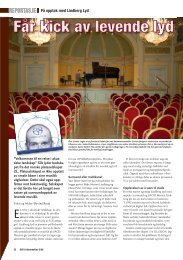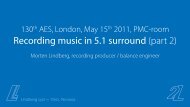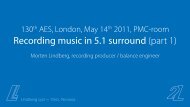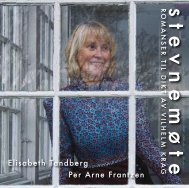The advantages of DXD for SACD
The advantages of DXD for SACD
The advantages of DXD for SACD
Create successful ePaper yourself
Turn your PDF publications into a flip-book with our unique Google optimized e-Paper software.
mathematical nature <strong>of</strong> the 1-bit signal, without<br />
converting the data to an edit <strong>for</strong>mat. Normally the<br />
recordings are edited and mixed with the signal<br />
converted to a PCM-like signal having a higher<br />
number <strong>of</strong> bits than one. This will theoretically involve<br />
a noise shaping process, thus introducing some<br />
degradation to the pulse response and the noise curve<br />
<strong>of</strong> the signal.<br />
A PCM recording can be made in the usual way,<br />
where the material is A-D converted to PCM, recorded<br />
and editing at one <strong>of</strong> the standard sample-rates <strong>of</strong> 44.1<br />
kHz, 88,2kHz or 176,4kHz followed by an<br />
appropriate DSD <strong>for</strong>matting system. This can use DSD<br />
A-D convertors, real-time <strong>for</strong>mat conversion s<strong>of</strong>tware<br />
(as a plug-in), or a s<strong>of</strong>tware ‘<strong>of</strong>fline’ process.<br />
<strong>The</strong> <strong>DXD</strong> recording is based on an A-D convertor<br />
directly outputting the <strong>DXD</strong> audio signal. <strong>The</strong> advantage<br />
<strong>of</strong> this type <strong>of</strong> recording is that the <strong>DXD</strong> signal can be<br />
edited directly thus being a higher resolution <strong>for</strong>mat<br />
than DSD. A benefit <strong>of</strong> this is that the out-<strong>of</strong>-band noise<br />
level is significantly lower than with the DSD signal. <strong>The</strong><br />
editing process is relatively insensitive to changes in the<br />
dynamic range relations between the recording<br />
channels and in the final mixed music.<br />
<strong>DXD</strong> is acknowledged by Philips and Sony as a<br />
high sample rate and multi-bit processing <strong>for</strong>mat <strong>for</strong><br />
recording and editing <strong>for</strong> <strong>SACD</strong> productions. <strong>DXD</strong> is<br />
defined as a 24-bit signal sampled at 352.8kHz. <strong>The</strong><br />
advantage <strong>of</strong> <strong>DXD</strong> is that the signal is not limited to a<br />
one bit representation like the DSD <strong>for</strong>mat. A-D<br />
convertors can there<strong>for</strong>e be used having a higher order<br />
delta sigma modulator <strong>of</strong> 5 bit, <strong>for</strong> example. Using<br />
higher order modulators in fact makes it possible to<br />
have a significantly lower level <strong>of</strong> high frequency<br />
noise, thus improving the conversion quality. Since the<br />
sample rate <strong>of</strong> <strong>DXD</strong> is 8 times 44.1kHz, the signal is<br />
easily up-sampled to DSD without any degradation.<br />
<strong>The</strong> data rate <strong>for</strong> a <strong>DXD</strong> mono signal is 24bit times<br />
352.8kHz, which is 8467,2MHz, being three times<br />
the data rate <strong>of</strong> the DSD64 signal.<br />
As with any recording system, the sonic quality is<br />
the most important parameter and recording engineers<br />
and artists will have to decide on the perceptual<br />
quality. In terms <strong>of</strong> technical specifications there are<br />
two measurements <strong>of</strong> particular interest <strong>for</strong> qualifying<br />
the per<strong>for</strong>mance <strong>of</strong> the recording set-up — out <strong>of</strong> band<br />
noise and pulse response.<br />
<strong>The</strong> following curves are generated from computer<br />
models <strong>of</strong> the different <strong>for</strong>mats, based on the basic theory<br />
and actual per<strong>for</strong>mance <strong>of</strong> convertors from Digital Audio<br />
Denmark and Merging Technologies [3] [4].<br />
Figure 1 shows the pulse response <strong>for</strong> the AD<br />
conversion, which is a measure <strong>of</strong> the timing precision<br />
<strong>of</strong> the digital representation <strong>of</strong> the signal.<br />
technology<br />
Two factors define the pulse response — the roll-<strong>of</strong>f<br />
frequency <strong>of</strong> the sampling filter (anti-alias filter) and<br />
the slope <strong>of</strong> the filter roll-<strong>of</strong>f. A high roll-<strong>of</strong>f frequency<br />
gives a high amplitude pulse because <strong>of</strong> more high<br />
frequency content being present. A slow roll-<strong>of</strong>f slope<br />
will produce less pre and post ringing <strong>of</strong> the pulse and<br />
thus a more precise time point <strong>for</strong> the pulse.<br />
Due to its relaxed filter slope and high bandwidth<br />
DSD has a perfect pulse transparency. <strong>The</strong> results are<br />
different <strong>for</strong> the different PCM rates. <strong>The</strong>se have a<br />
higher pulse when the sample-frequency increases,<br />
but the steep filters needed to comply to Nyquist (i.e.<br />
having full attenuation around the half sample<br />
frequency) will have the effect <strong>of</strong> pre and post ringing.<br />
At the higher rates a more relaxed approach can be<br />
made towards the filter steepness since the risk <strong>of</strong><br />
having audio contents folded down is very small as<br />
the efficient amplitude <strong>of</strong> the audio is very low at rates<br />
beyond 50kHz, <strong>for</strong> example.<br />
Figure 2 shows the frequency response <strong>of</strong> the<br />
different <strong>for</strong>mats. Figure 3 shows the out <strong>of</strong> band noise<br />
spectrum as an FFT.<br />
This clearly indicates that A-D conversion in DSD at<br />
64fs, has a high noise level that adds up when more<br />
channels are recorded and mixed. As can be seen <strong>DXD</strong><br />
has a lower noise spectrum than DSD, which at 60kHz<br />
is 50dB lower.<br />
<strong>The</strong> Scarlet Book is a set <strong>of</strong> technical specification<br />
<strong>for</strong> <strong>SACD</strong> media, the digital audio signal stored on the<br />
media, and specifications <strong>for</strong> the equipment playing<br />
the audio and data <strong>of</strong>f the <strong>SACD</strong>. <strong>The</strong> Scarlet Book is<br />
equivalent to the Red Book specification <strong>for</strong> CD.<br />
Figure 3.<br />
In terms <strong>of</strong> specifications <strong>for</strong> the audio signal, a limit<br />
is set <strong>for</strong> the noise spectrum <strong>of</strong> the DSD signal on the<br />
<strong>SACD</strong> disc. <strong>The</strong> accumulated RMS noise in the<br />
July/August 2004 resolution<br />
frequency band between 40kHz and 100kHz with<br />
30dB/oct slopes must not exceed -20dB (<strong>SACD</strong> level)<br />
[5]. This specification is close to what can be achieved<br />
by most DSD A-D convertors and there<strong>for</strong>e very<br />
sensitive to any noise deterioration in the editing<br />
system. <strong>The</strong> DSD noise curve in Figure 3 has an RMS<br />
noise <strong>of</strong> -23.5dB.<br />
So how do you make the ideal recording <strong>for</strong> <strong>SACD</strong>?<br />
Because <strong>of</strong> the technical aspects <strong>of</strong> <strong>DXD</strong>, <strong>DXD</strong> is the<br />
most suited <strong>for</strong>mat <strong>for</strong> recording a signal with the<br />
highest quality. Since <strong>DXD</strong> is a PCM-like signal, editing<br />
can be made using conventional lossless digital<br />
processing, just operating at 8 times FS. <strong>The</strong> signal can<br />
be converted to DSD <strong>for</strong> authoring the <strong>SACD</strong>. <strong>DXD</strong> can<br />
also be converted to the standard PCM rates using<br />
sample-rate conversion still maintaining that the final<br />
mastering <strong>for</strong>mat will set the quality standard <strong>for</strong> the<br />
music production. One drawback <strong>of</strong> <strong>DXD</strong> is the high<br />
data rate <strong>of</strong> the signal as it is 8 times FS but with the<br />
evolution <strong>of</strong> workstations this is only a temporary<br />
limitation. Today 16 channels <strong>of</strong> <strong>DXD</strong> can be recorded<br />
and edited [4].<br />
DSD64 is not, on the other hand, so well suited to<br />
multichannel recording, because the DSD out-<strong>of</strong>-band<br />
noise will significantly contribute to the overall noise<br />
per<strong>for</strong>mance <strong>of</strong> the production, depending on the<br />
actual mix and the relationship in terms <strong>of</strong> dynamic<br />
range between the channels. As specified in the Scarlet<br />
Book, there is a requirement <strong>for</strong> the final <strong>SACD</strong><br />
production to respect the limits <strong>for</strong> the out-<strong>of</strong>-band<br />
noise. This specification can be difficult to comply<br />
with, when noise is adding up from more channels.<br />
Sampling in DSD128 does make a significant<br />
improvement in the noise <strong>of</strong> the recording. However, it<br />
is still necessary to <strong>for</strong>mat convert the signal just as<br />
with DSD64 to do editing and thereby gives a<br />
degradation to the overall recording.<br />
A more pragmatic solution would be to record at<br />
88.2kHz PCM if the final mix has to be <strong>SACD</strong> or<br />
96kHz if it has to be DVD-A. In the case <strong>of</strong> <strong>SACD</strong> the<br />
PCM mix can be DSD converted in the authoring<br />
process. <strong>The</strong> recording in general will, <strong>of</strong> course, be<br />
limited to the pulse response <strong>of</strong> 88.2kHz PCM, but on<br />
the other hand depending on the actual music being<br />
recorded (i.e. the high frequency response <strong>of</strong> the<br />
material) this might not be a real problem. This type <strong>of</strong><br />
recording will not have problems in complying with<br />
the Scarlet Book requirements.<br />
<strong>The</strong> conclusion is actually very simple. For music<br />
recording studios to decide on practical<br />
implementations, the DSD, the PCM and the <strong>DXD</strong><br />
approaches can be used separately or combined. To<br />
qualify a <strong>SACD</strong> recording system, you need to evaluate<br />
the system per<strong>for</strong>mance in terms <strong>of</strong> out-<strong>of</strong>-band noise<br />
and pulse response, and the perceptual sound quality.<br />
Various implementations can be made <strong>of</strong> the basic<br />
three <strong>SACD</strong> recording set-ups, and most <strong>of</strong> them give<br />
very good quality when used correctly. However, <strong>DXD</strong><br />
should be considered seriously when setting up<br />
systems <strong>for</strong> the absolute highest sound quality. ■<br />
References<br />
[1] www.superaudio-cd.com<br />
[2] Why DSD is the best choice as a digital audio<br />
<strong>for</strong>mat, AES paper 2001<br />
[3] www.digitalaudio.dk, AXION audio convertor<br />
[4] www.merging.com, Sphinx2 audio convertor<br />
[5] <strong>SACD</strong> Audio Signal Properties, Scarlet book,<br />
Marts 2003<br />
61








